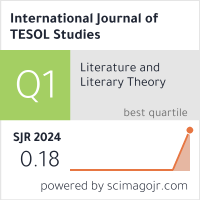2632-6779 (Print)
2633-6898 (Online)


Scopus
Ulrich’s Periodicals Directory (ProQuest)
MLA International Bibliography
MLA Directory of Periodicals
Directory of Open Access Journals (DOAJ)
QOAM (Quality Open Access Market)
British National Bibliography
WAC Clearinghouse Journal Listings
EBSCO Education
ICI Journals Master List
ERIH PLUS
CNKI Scholar
Gale-Cengage
WorldCat
Crossref
Baidu Scholar
British Library
J-Gate
ROAD
BASE
Publons
Google Scholar
Semantic Scholar
ORE Directory
TIRF
China National Center for Philosophy and Social Sciences Documentation
Thanh Vinh Chau
Thao Quoc Tran
Ho Chi Minh City Open University, Vietnam
Abstract
To capture Vietnamese high school English teachers’ driving forces and barriers in enacting the Competency-Based English Teaching Curriculum (CBETC), this study presents the method of designing and developing a questionnaire. It also validates its structure and reliability when used as a survey in the classroom. The relevant theories were analyzed to construct their content and form. Two techniques, Exploratory Factor Analysis (EFA) and Confirmatory Factor Analysis (CFA), were utilized to assess the construct validity and reliability, while internal consistency was evaluated using Cronbach’s alpha (α). The results showed that the questionnaire identified dimensions of impetus through three distinct factors: English curriculum-related, teacher-related, and teaching method-related. Similarly, hindrances were measured through three corresponding factors: English curriculum-related, teacher-related, and institution-related aspects. EFA and CFA results confirmed the construct validity of the instrument, with the impetus scale comprising 10 items across three factors (KMO = 0.77; p=0.000; Chi-square/df = 2.066, GFI = 0.976, CFI = 0.982, RMSEA = 0.045; PCLOSE = 0.665; α = 0.79; and CR=0.825), and the hindrance scale comprising 12 items also grouped into three factors (KMO = 0.84; p<0.001; Chi-square/df = 1.912; GFI = 0.969; CFI = 0.982; RMSEA = 0.042; PCLOSE = 0.845; α = 0.84; and CR=0.845). These findings indicate that the instrument demonstrates acceptable levels of validity and reliability, supporting its use in future research on teachers’ motivational and contextual factors influencing CBETC implementation.
Keywords
CBETC, impetus, hindrances, questionnaire development, curriculum enactment, instrument validation